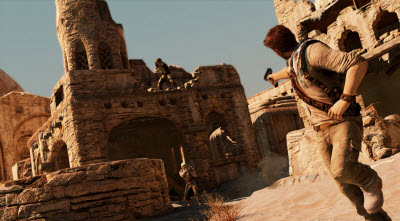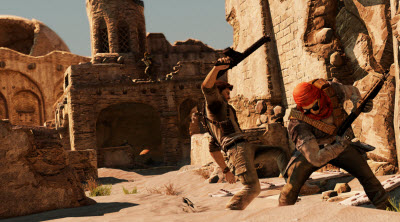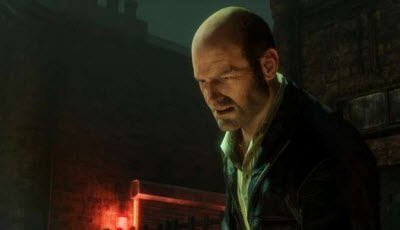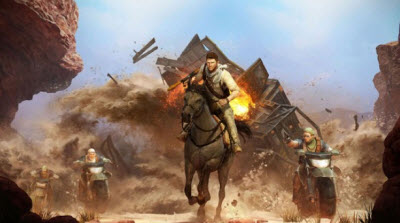 VB: I suppose if you have 500 people on a team like Activision on Call of Duty, then you can do one of these every year right?
VB: I suppose if you have 500 people on a team like Activision on Call of Duty, then you can do one of these every year right?
JR: [Laughs.] Sure. I mean that’s a bit tricky but I think the thing is for us, the reason people love to work here is that everybody is really in direct control over everything they do. The way we make games is say this is what we want to do as a company. We get behind something and go hard on it. So we don’t want to be stuck in a place where people in the company feel like they are trapped on a project and it is something that is not interesting to do. You never get great results that way and so we have always sort of pushed ourselves to try and do something that everybody is interested in doing.
VB: But your fans want something every year right?
JR: Of course. I wish we had the manpower for that. But I think in other sense I think you end up getting intellectual property fatigue. You can get burned out on it, if you don’t have time to innovate on it and make it different each time in some way. People can burn out on the franchise a lot faster.
VB: I never quite remember how long it takes to play these games?
JR: I think the average player takes 10 to 12 hours. But that is comparable for Uncharted 2.
VB: I was partly delirious, since I was playing while sick.
JR: That’s a rough deal.
 VB: As far as other kinds of tips go, have you been telling people about any particular ways to play the game?
VB: As far as other kinds of tips go, have you been telling people about any particular ways to play the game?
JR: One thing that we encourage people to do is that there is a huge amount of content — if you don’t want to play competitive multiplayer — we also have this cooperative content which is basically five or six short stories in sort of alternate reality version of Uncharted which people can play. We try to encourage people to go and play that stuff in the club section. It is really fun and it has all the favorite characters in there. It has these stories and little moments and sort of the extracts from the single-player campaign, in a light narrative version of that. We are encouraging people to go and play that co-op version because it is fun and we don’t want people to miss out on that just because it is online. It shouldn’t scare people off.
I think you can even actually want to play it on offline mode where you can sit down on the couch and play it split-screen play with a friend sitting right there without him having to log in. But as far as the single-player campaign, I think ideally people find their own way. We try not to be very heavy-handed with tips and so we don’t want to give them up. We want them to experience the play.
VB: How is multiplayer turning out from your perspective?
JR: I think we have got better numbers as last time. I think we got a huge amount of content there. I think it is a lot of fun to play and we offer some things that’s really different from the Battlefield or the Call of Duty games out there. It is a very dynamic battlefield that has a ton of verticality. It has tons of different types of roles you can do. There is a lot of customizability for the look of your character and the types of weapons and game play style that you can use. We had a lot of fun in the office playing. The fans are having fun. From our view, it has gone well.
VB: How do you guys do the rendering of the sand? Did that take some really special expertise to have a firefight in the sand storm?
JR: Actually we sent a bunch of our particle and background artists out to the desert and had them roll around in the sand for a couple of days. We did that because we wanted that to be so realistic. We spent a lot of time making that it felt real and looks real. We wanted you to feel like you are actually inside of that sand cloud and that it is not just something painted on the horizon. It actually affected the game play.
 VB: And how did you guys think about adding the new characters and designing for Charlie Cutter and Katherine Marlowe?
VB: And how did you guys think about adding the new characters and designing for Charlie Cutter and Katherine Marlowe?
JR: Basically, we knew we wanted to have this anti-group character, the guy on the inside of the organization. When we got Graham McTavish on the set — he actually played Zoran Lazarevic in Uncharted 2 — and we saw him work with the other characters, we decided we had to blow him out even more and make him an even bigger character. So we did and we ended up actually expanding his part because of the way they interacted with each other on stage. It is always interesting to see. Amy will write something and then do a table read and sit down and we see how the actors play with it. Then we take it from there and sometimes we will get results that we didn’t expect. It’s sort of like seeing the filming of a TV show with the actors performing week after week. It is not like they are recorded and then they leave. They are really living with the project. The actors bring something to it, like Graham did with Charlie and Rosalind Ayres did with Katherine Marlowe.
VB: It’s interesting that the actors have a role in defining these characters that you create for the game.
JR: Yeah. I don’t know how the serials work but I think it is different. We have somebody come in and read for a part. We often have no one there for them to interact with. We think about how this person with interact with Drake’s character. We take it very seriously and often times the actors have great ideas and we listen to them. And often the best comes from the actors just reacting in the moment. That is how collaborative the environment is.

